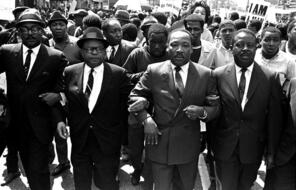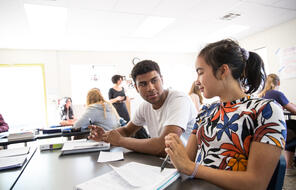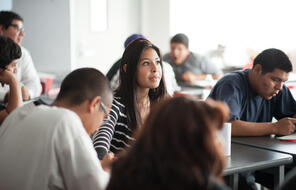“I’d Do it All Over Again”: Last Hurrah for the Veterans of Cable Street
Language
English — UKUpdated
On 9th October 2016, residents, politicians, Bangladeshi associations, trade unions, synagogues, and anti-racist groups commemorated the 80th anniversary of the historic 1936 Battle of Cable Street with a march and rally in East London. In this article from The Guardian, individuals who participated in the 1936 protest as teenagers recall the event and draw connections between the antisemitism that the East End Jewish population faced with the discrimination and racism targeted at the neighbourhood’s Bangladeshi community today.
It was a day that shaped Willie Myers’s life. A few weeks before his 15th birthday, the Jewish lad from the East End of London joined thousands to block the passage of fascists through their community.
"The violent fray – between Jews, Irish dockers, trade unionists, communists, Labour party members, housewives and children on the one hand, and police and fascists on the other – on 4 October 1936 went down in history as the battle of Cable Street. Eighty years on, Myers is one of a handful of participants still alive to pass on his memories and the lessons he has carried through his life.
“I remember the day so vividly, I can see it clearly,” he said. “After Cable Street, we carried on the fight against fascism and racism. Even today, if I had to do it all over again, I would. We haven’t learned the lessons of the past. Prejudice is still directed at Jews, but it’s even worse towards Muslims. When I hear of Muslims, or Polish people, being attacked today, I feel angry. I cannot fathom out why we can’t see each other as human beings. If we’re cut, we all bleed the same.”
On 9 October, Myers will join the mayor of London, Sadiq Khan, and the chief rabbi, Ephraim Mirvis, at an event hosted by the London Jewish Forum to commemorate the 80th anniversary of the battle. It will follow a march and rally in east London organised by Cable Street 80, an ad hoc coalition of trade unions, Bangladeshi associations, synagogues and anti-racist organisations, to be addressed by Labour leader Jeremy Corbyn. “This anniversary is particularly important because it’s probably the last one where we’ll hear the voices of people who were there,” said David Rosenberg of Cable Street 80. “Most are now well into their 90s. We should honour the people who fought against fascism and show our commitment in the present and the future against racism and prejudice and for a multicultural society.”
Adrian Cohen of the London Jewish Forum said: “Cable Street is a notable event in its own right, but also part of the heritage of London Jewry. Most of the Jewish community is no longer based in east London, but this is something we don’t want to lose.”
In 1936, Hitler’s Nazis were gathering strength across Europe. In Spain, the civil war between Republicans and Franco’s Nationalists – aided by Hitler and Mussolini – was galvanising socialists and communists to join the fight against fascism. In Britain, Sir Oswald Mosley’s blackshirted and jackbooted British Union of Fascists was seeking to stir up anti-Jewish hatred among working-class Londoners. Mosley announced his forces would march through the East End.
After the government refused a request by local groups for a ban, there was disagreement over how to respond. The Jewish Board of Deputies and the Labour party were against confrontation. “Jews are urgently warned to keep away from the route of the Blackshirt march and from their meetings,” said the Jewish Chronicle. “Jews who, however innocently, become involved in any possible disorders will be actively helping antisemitism and Jew-baiting. Unless you want to help the Jew-baiters, keep away.”
The advice was widely rejected by the people of east London, and especially by the Communist party, which was building a popular front against fascism. Myers, who had recently joined the Young Communist League, ignored his father’s warning to stay away. “I was fired up and ready for a big battle. And it was a big battle! I’d never seen so many people in my life,” he said.
About 300,000 people turned out to block the fascists and the police who were protecting their march. Barricades were built from paving stones, tables and chairs, mattresses; women emptied dustbins and chamber pots from windows on to the heads of policemen; children threw marbles under the hooves of police horses. According to newsreel reports, about 6,000 police were deployed. “Communists, Labourites and Jews jam the fascist route, resisting the peaceful efforts of the outnumbered police to clear a way,” ran the commentary, showing young men clenching their fists in a universal symbol of resistance.
The crowds shouted the Spanish civil war slogan “No Pasarán!” – they shall not pass – and “One, two, three, four, five – we want Mosley, dead or alive”. Bill Fishman, a social historian who died in 2014 aged 93, recalled the scene: “We all charged towards Cable Street. At the bottom end, an overturned lorry was used as a barricade and we blocked the road – Hasidic Jews with little beards and great strapping Irish dockers all standing together. People began to throw down their mattresses to block the street and a mass onslaught on the police ensued, with two officers even being taken hostage.”
The newsreel showed punches being thrown and mounted policemen swinging truncheons at the crowds. “Batons are drawn and heads are broken as the anti-fascist demonstrators resist efforts to disperse them,” ran the commentary. For teenage Myers, it was an eye-opener. “I had a great opinion of the police until then. Our local copper was a friendly man, he knew everyone. But when I saw the baton charges, I changed my mind there and then. It seemed to me they were doing the work of the fascists for them.” After hours of running battles, including about 80 arrests and scores of people treated at ad hoc first-aid stations, word came that the fascists had turned back. The crowd was triumphant. “Everyone was embracing,” said Fishman.
Eighty years on, the issues faced in Cable Street in 1936 have not gone away, said Rosenberg. “There is still racism and neo-fascism across Europe. Here in the UK, the explicitly fascist organisations are very fragmented, but in the post-Brexit climate racism and xenophobia are on the increase.” The tactical debates around Cable Street have strong echoes today, said Cohen. “To what extent should you confront the radical right directly, or should you ignore them, deny them the oxygen of publicity?”
In the 1930s, the population in the area around Cable Street was more than 50% Jewish. In the postwar years, the community largely moved north, to Hackney, Stamford Hill and Golders Green.
There has also been political change. In the 1930s, Jews were the stalwarts of the Communist party, fighting not just against fascism and racism but also for workers’ rights and social justice. Now many British Jews are suspicious of the left and its views on Israel, with many believing antisemitism lurks behind support for the Palestinian cause. Today, more than half the population of the London borough of Tower Hamlets are black or ethnic minority, with 32% of Bangladeshi heritage. According to the 2011 census, white British residents formed 31% of the local population, against 80% nationally.
A huge mural commemorating the 1936 battle covers one end of St George’s town hall on Cable Street. Passersby one lunchtime last week encapsulated the diverse melting pot of London: a Gambian, Romanian, Italian, Lithuanian, Irishman, Iranian and a history student from Bristol. Danny, the student, had come to see the epic mural. “Given the current climate, the battle of Cable Street still has enormous relevance,” he said. “There are rightwing nationalist movements in France, Germany, Austria – and here we have UKIP. The way things are going, future generations need to learn the lessons.” 1
- 1Harriet Sherwood, “‘I’d do it all over again’: last hurrah for the veterans of Cable Street", The Guardian, September 24, 2016. Reproduced with permission of The Guardian.
How to Cite This Reading
Facing History & Ourselves, ““I’d Do it All Over Again”: Last Hurrah for the Veterans of Cable Street”, last updated June 8, 2018.















